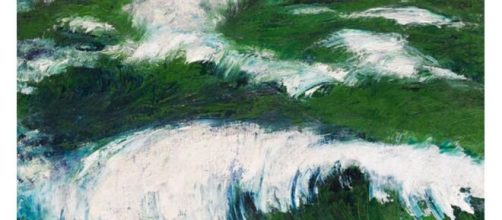This writing comes down to what constitutes religious art. Germany’s leading art auction house, Ketterer Kunst, will offer one of Expressionist Emil Nolde’s seascapes on Dec. 9. Art Daily considers the sea a “key theme” of Nolde’s work.
But, it’s Nolde’s technique that contributes to the value of his seascapes, says Mario-Andreas von Lüttichau, curator at the auction house: “Nolde’s characteristic expressive brushwork and the intensive colors make the choppy sea tangible.”
“Brushwork” may not be an accurate way to describe Nolde’s technique. Fellow Expressionist George Grosz also called attention to Nolde’s technique for seascapes in his autobiography.
He said that when inspiration came to Nolde, he threw away his paintbrushes, dipped some rag in paint, and “in blissful delirium, wiped it all over the canvas.”
Distortions on purpose
All that said, you’d think the sea called to Nolde. Yet a part of his output – admittedly a relatively small part – was religious paintings. And they are no more traditional looking than his seascapes. What you see are bizarre distortions and clashing colors, presumably to convey deeply felt feelings about the subject.
His nine-part series “Life of Christ” comes to mind. “The Nativity,” for example, shows Mary solemnly holding the Christ child high above her as Joseph looks on with wonder. Each figure is painted in simple, flat shapes, which has the effect of making the image more heartfelt.
His version of “The Last Supper” is full of oversimplified forms in jarring colors that one might call primitive. Christ, seen in a prayerful stance, wears a shrill red robe and hair to match, which comes across as glowing in the dark.
With all the fierce coloring and flat shapes, it’s hard to overlook Nolde’s work. Adding to their impact is something he confided to his friend Friedrich Fehr about his childhood, explaining his religious zeal.
Nolde said that when he was eight years old, he made a solemn promise to God that, when he grew up, he would write a hymn for the prayer book. While he never fulfilled that vow, he painted more than thirty religious pictures and wondered if they would do it instead.
Hymns to the sea
His seascapes may well be viewed as hymns. Many of them suggest the narrative in Genesis when the earth was empty and had no form, when darkness covered the ocean, and sky and earth came into being.
Nolde’s “Color is Life” looks like that, an evocation of the dividing of the light from the darkness when the waters gathered under the sky, and the light in the sky divided day from night, giving light to the earth.
Of course, it may be fair to say that all art, no matter the ism, is a form of expression. But artists like Nolde focused exclusively on conveying their emotions in the late nineteenth and early twentieth centuries. Their imagery, while recognizable, is not about the visible world.
Isn’t that what a hymn is, what all music is? Its strains are not about the sounds of the natural world but rather about feeling. Nolde’s picture-making has that air of music, although to me, it’s less hymnal and more harmonious. (Mahler, maybe).


